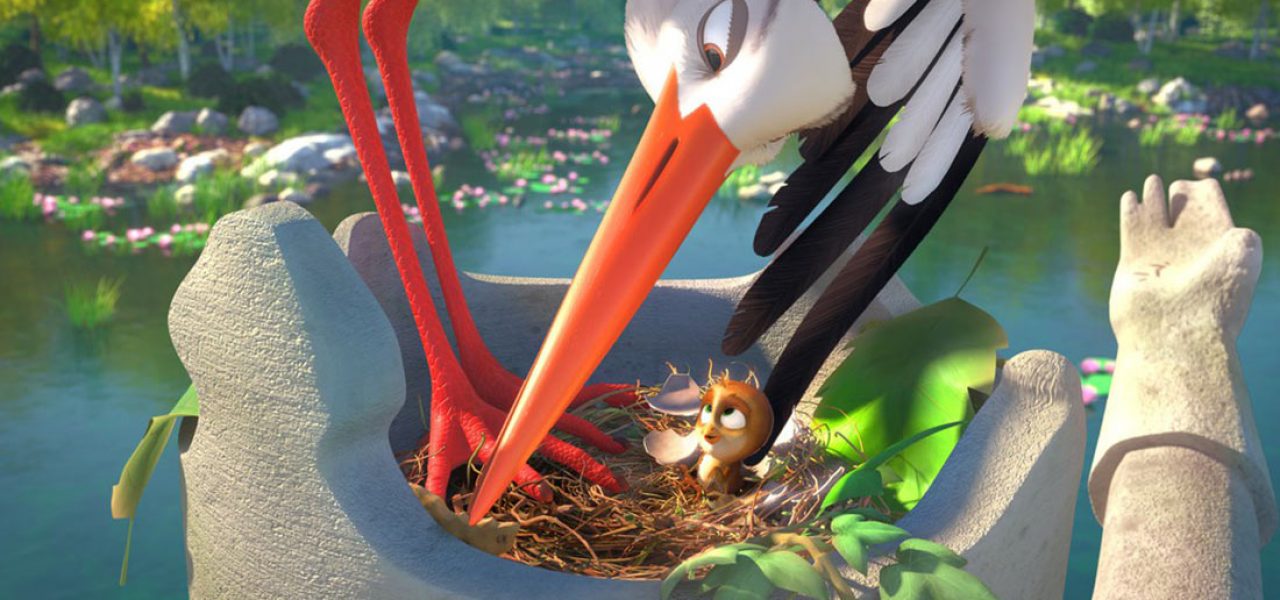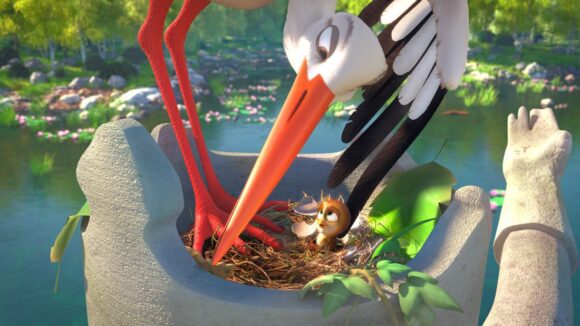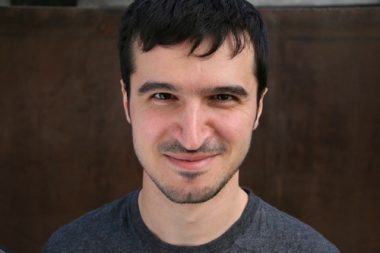

ANNECY 2017: The Long Journey Behind The German Indie Feature ‘A Stork’s Journey’
Director Toby Genkel’s A Stork’s Journey began its life more than a decade ago. Made as a co-production among four different European countries, the process of pitching the story, obtaining funding, and then finishing the independent animated feature, was a long road.

But the film, which is about a sparrow who thinks he is a stork, is screening at Annecy this week, and has now been released in several markets (it’s known as Richard the Stork in Europe). Another recent major step has been securing U.S. and Canada distribution. This is via Lionsgate, with the film available on Google Play for free until June 28, followed by a theatrical release on June 30, and then a home video and digital online release on July 4.
Cartoon Brew spoke to the film’s writer and co-director Reza Memari about the challenges of telling an original story and making an independent animated feature in Europe.
The origins of Richard
Memari came up with the story idea while working as a film editor in television. He’d previously been involved in marketing and PR for video game studio Acclaim Entertainment, the makers of Mortal Kombat. Writing screenplays was something he did on the side.
“One day I was in Munich and I was looking at a group of sparrows eating french fries in front of a McDonald’s,” Memari told Cartoon Brew. “I look up, and I see a flock of geese flying south in a formation, so I knew that they were going to migrate to Africa. I look to my friend, and I ask him, ‘Is it weird that sparrows don’t fly to Africa?’ And this question – why don’t sparrows fly to Africa when everyone else is going, why do they have to stay in the cold?’ created a character in my head, who was Richard already, who was clenching his fists and saying, ‘It’s not fair!’”
Although Memari felt this could be an original idea for an animated film, he did not immediately set out to write it. Some time later, however, he met producer Kristine Knudsen at a party in Berlin. He shared his animation idea and Knudsen suggested he write it down.
The concept would eventually be submitted for script funding in Germany. “This was my first time I ever wrote a feature film,” said Memari. “Right away, we got 30,000 euros, and that seemed like such a blessing and such an early wink from the universe, that this might be worth our while. I used that money to start writing it and start developing the story.”
During the writing process, Memari and Knudsen – both new to the animation industry – attended European animation conferences, meetings, and pitching opportunities. Memari attended a script lab in Germany, and also worked with some artists to do some early visual development.
Memari was clear at this stage, too, that he didn’t want to make an ‘art house’ film, but instead one with wider appeal. “I love art house, and how much you can do, and how far you can go in terms of the storytelling and the depth and the darkness, but also the experimental side of it all. But we were not doing that. I think you can make appealing films with a lot of heart and emotion for a wide audience.”

Finding more funding, and a footing
After about three drafts of the screenplay, the pair began talking to co-producers, distributors, and worldwide sales companies. That process, however, took time, and it was not until 2014 that production began with a budget of 10 million euros. Memari had deliberately approached only European partners in financing and producing the film.
“We decided early on to make it in Europe, and to not go into India or Malaysia or China, to help us out,” he said. “I think the thinking was: this is our first time, and this is also very precious to us, and we didn’t want to make it complicated in terms of time zones, and vastly different cultures. We wanted to make it as smooth as we could, while still working with three other countries. These were Belgium, Luxembourg, and Norway, and then of course we were already in Germany.”
The producers ultimately became Kristine Knudsen (Knudsen & Streuber Medienmanufaktur, Berlin, Germany) and Emely Christians (Ulysses Filmproduktion, Hamburg, Germany). The co-producers were Eric Goossens (Walking the Dog, Brussels, Belgium), Stephan Roelants (Mélusine Productions, Luxembourg, Luxembourg), and Den Siste Skilling (Bergen, Norway). Animation production took place at Rise FX in Berlin, Studio Rakete in Hamburg, Walking the Dog in Brussels, Studio 352 in Luxembourg, Bug in Bergen, and Nordisk ShortCut in Oslo.
Co-ordinating production between four separate countries was, expectedly, a major challenge. “Each country has its own point system that you have to account for,” said Memari. “Every funder wants their own talent in their country. Our art director, who’s also the assistant director, was in Luxembourg, for example. The composer was in Belgium, and the sound production was done in Norway.”
The director, Toby Genkel, was based in Hamburg. Genkel has worked for more than two decades in animation and was brought onto the production based on his significant European experience. “What was so amazing about him,” said Memari, “was that any director who was going to come in needed to understand the relationship between Kristine and I, and the time and the history of this project, and really be able to do it without feeling like, ‘This is not my project.’ We wanted somebody who could also really make it his, while still respecting all the history that went before him.”
Despite the many European locations for production, the filmmakers always planned to release the film in English. “English is snappier, and the jokes work better and easier,” suggested Memari. “Also, if you want to make a film of this size, then you basically have to be in English.”

Just getting it made
Looking back, Memari recalls a lot of ‘closed doors’ when he was after funding and advice on the film, especially given he had no track record in making film. He also admits not knowing just how hard production would be.
“I was really surprised by how complex it was,” he said. “Just the asset management, and the asset approval, in animation is insane. It’s ridiculous. Of course we don’t have the same amount of staff that American films enjoy, where you have all kinds of leads, and all kinds of department heads that do pre-approvals. We were basically working around the clock sometimes just keeping the machine running. Anyone who does animation knows that animation is kind of hell. Everybody loves it, but it is a lot of work.”
Asked for any advice to others who might be thinking about making an animated feature, Memari says it is vital to check and re-check that what is being made is still appealing and still working. “Are these jokes funny? Are people actually laughing, or is everyone just politely smiling and awkwardly looking away? That’s what you need to look for.”
“Are people crying? That’s something else I ask,” added Memari. “You don’t know how many people I’ve seen cry, and how happy that makes me. Not because I like to torture people, but because it’s such an amazing thing to know that you have moved somebody, and that somebody can connect deeply with something that comes out of your head. It’s such a crazy, amazing feeling, and I’m so grateful.”


.png)